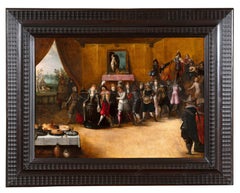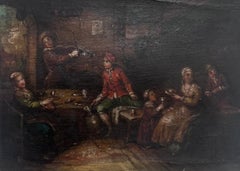18th Century and Earlier Interior Paintings
to
17
21
11
17
14
14
Overall Width
to
Overall Height
to
77
390
2,010
5,225
33
43
62
104
82
124
147
160
125
109
44
31
47
29
63
42
38
19
17
7
5
4
4
4
3
2
2
2
2
2
2
2
1
1
74
72
41
41
9
1
1
1
1
51
12
70
6
Period: 18th Century and Earlier
Attributed à H. Francken II, 17th c. Anwerp - The prodigal son among courtesans
Located in PARIS, FR
The Prodigal Son Among Courtesans
Attributed to Hieronymus Francken II (Antwerp 1578-1623)
Early 17th century Antwerp school
Oil on oak panel,
Dimensions: H. 52.5 cm (20.67 in), W. 74 cm (29.14 in)
Flemish-style moulded wood frame
Frame: h. 78 cm (h. 30.70 in.), w. 100 cm (39.37 in.)
At first glance, this festive and joyful painting depicts a group of elegantly dressed people dancing to the sound of an orchestra in a richly decorated interior with a wide opening onto a rural exterior. However, the real theme is cleverly concealed by the painter and is only discernible through the artifice of a small scene in the background where we see a half-naked man, in the company of the pigs next to a makeshift shelter.
In fact, beyond the pleasant and apparently superficial character of the painting, it is a subject taken from the parable of the prodigal son in the Gospel. The illustrated episode is the prodigal son among courtesans.
Even if the viewer's attention is drawn to the central couple (prodigal son embracing a pretty courtesan) doing the dance steps, the artist takes care in a narrative approach of all the groups and ancillary scenes in order to create a rich and varied composition. Thus the musicians seated on a raised platform are depicted with great skill, their faces animated, their clothes abundantly varied.
The theme of music, which has always been associated with that of sensuality and physical love, helps to exacerbate licentious pleasures.
The merry company dances "Spanish pavane", a slow court dance from the sixteenth century, danced close to the ground by couples arranged in a procession, which was probably introduced to the south of the Netherlands around 1600 during the governance of Albrecht VII and the daughter of the King of Spain Isabella Clara Eugenia in Brussels.
The interior of the house is also carefully elaborated, the embossed leather dyes on the walls, the middle sideboard (typical in Francken interiors), where the rich gold and silver crockery is placed in front of the painting "Andromeda chained to the rock and Perseus arriving to rescue her". The inclusion of a contemporary and probably extant pictorial work is also one of the characteristics of the Francken family, among them Frans Francken the Younger...
Category
Old Masters 18th Century and Earlier Interior Paintings
Materials
Oak, Oil
Baroque silver Vase with Flowers with a Fruit Tray and a Clock by A. Zuccati
Located in PARIS, FR
This unpublished composition is a recent addition to Adeodato Zuccati’s catalog. The study of this painting by Gianluca Bocchi, an Italian art historian specializing in Italian still lives, is available upon request.
This composition is typical of the productions of Adeodato Zuccati, an Emilian painter...
Category
Old Masters 18th Century and Earlier Interior Paintings
Materials
Canvas, Oil
18th Century French Oil Painting Tavern Scene Interior Figures & Violin Player
Located in Cirencester, Gloucestershire
Violin Player in Tavern
18th century French School
oil on canvas
canvas: 8 x 11 inches
provenance: private collection, France
condition: good and sound condition
Category
Old Masters 18th Century and Earlier Interior Paintings
Materials
Oil, Canvas
Mother with Child, Rose, Old Master, Figurative Painting, Love, Christmas Scene
Located in Greven, DE
L. Franssen
Mother and child with a rose
Oil on wood, 44,5 x 33,5 cm
signed
The artist of this outstanding painting is completely unknown so far. There is no entry under "L. Franssen" in any encyclopaedia or reference work. There was a Dutch artist, Jan Fransen (1604/5 - ca. 1646), who was mainly based in Amsterdam. According to Thieme/Becker, he created numerous paintings with biblical depictions, study heads and still lifes. However, it could also have been Jan Franssen or Frantzen, who was not born until 1644 but was also active in Amsterdam. However, no confirmed works by either artist are known.
Just as interesting as the attribution is the depiction: a young woman holds her child on her lap while she prepares a meal on a hob. At the same time she holds a rose in her hand. Most likely, Mary is depicted here with the young Jesus...
Category
Romantic 18th Century and Earlier Interior Paintings
Materials
Oil
Circle of Adriaen Brouwer
Located in Milan, IT
Circle of Adriaen Brouwer (Oudenaerde, 1605/1606 - Antwerp, 1638)
Pipe smoker in a tavern
Oil on panel, 18 x 23 cm
The precious tablet belongs to the circle of Adriaen Brouwer, a ...
Category
18th Century and Earlier Interior Paintings
Materials
Oil, Board
"Eucharistic miracle of the mule and the heretic before Saint Anthony of Padua"
Located in Edinburgh, GB
Francesco Belotto (1721–1780)
"Eucharistic Miracle of the Mule and the Heretic Before Saint Anthony of Padua"
Framed: 82 x 170 cm
Flat: 76 x 161 cm
Medium: Oil on canvas
This dramat...
Category
Realist 18th Century and Earlier Interior Paintings
Materials
Canvas, Oil
La cuisinière écaillant le poisson dans une cuisine
Located in ROUEN, FR
VAN GRIEF Adrien dit GRIFF. (1670-1715). « La cuisinière écaillant le poisson dans une cuisine avec une très jolie nature morte au gibier, légumes et chiens ». Huile sur toile signée...
Category
French School 18th Century and Earlier Interior Paintings
Materials
Oil
Old Master Style Inn Interior with three men drinking around a table
Located in Woodbury, CT
This 18th-century painting, attributed to Christian Wilhelm Ernst Dietrich (1712–1774), depicts a rustic inn interior, a subject frequently explored by Dutch and German genre painter...
Category
Old Masters 18th Century and Earlier Interior Paintings
Materials
Wood, Oil
Fine 17th Century Still Life Oil Painting Italian Old Master Fruit on Ledge
Located in Cirencester, Gloucestershire
Ornate Classical Fruit Still Life
Italian School, 17th century
oil on canvas, unframed
canvas: 22 x 27 inches
provenance: private collection, UK
condition: very good and sound condi...
Category
Old Masters 18th Century and Earlier Interior Paintings
Materials
Oil, Canvas
The Market - Painting - 18th Century
Located in Roma, IT
The Market is an original old master artwork realized in the 18th century by an Anonymous Flemish artist.
Oil painting on canvas. The artwork depicts a bargaining scene at the marke...
Category
Baroque 18th Century and Earlier Interior Paintings
Materials
Oil
17th Century Genre Painting -- The Pipe Smoker
Located in Soquel, CA
Wonderful genre painting from 18th Century of pipe smoker. Signed lower right edge with monogram "I I E". Oil paint on copper. Condition: good: minor wear/rubbing from frame's rabbet...
Category
Realist 18th Century and Earlier Interior Paintings
Materials
Copper
Objekt №3. PSEUDEMYS (3) by Vasili Zianko, author's volume-contour technique
Located in Zofingen, AG
This art - work is part of the project REFLEXUS.
The paint is made in the author's technique of painting by Vasili Zianko based acrylic painting on canvas using a variety of texture...
Category
Art Nouveau 18th Century and Earlier Interior Paintings
Materials
Canvas, Acrylic
18th Century Oil on Canvas English Genre Scene Painting, 1750
Located in Vicoforte, IT
Antique English painting from the second half of the 18th century. Framework oil on canvas depicting genre scene with characters of good pictorial quality. Large size and impact pain...
Category
18th Century and Earlier Interior Paintings
Materials
Canvas, Oil
After the Hunt, Jan Josef Horemans the Younger, Antwerp 1714 – 1790, Flemish
By Jan Josef Horemans the Younger
Located in Knokke, BE
After the Hunt
Jan Josef Horemans the Younger
Antwerp 1714 – 1790
Flemish School
Signature: Attributed to Jan Josef the Younger Horemans
Medium: Oil on canvas
Dimensions: Size incl...
Category
Flemish School 18th Century and Earlier Interior Paintings
Materials
Canvas, Oil
1795-1816 Interior Of The Museum of Monuments Français
Located in PARIS, FR
Interior Of The Musée Des Monuments Français
View Of The 17th Century Hall
Anonymous between 1795 - 1816
Gouache on paper mounted on cardboard
74 x 88 cm
According to the old label...
Category
18th Century and Earlier Interior Paintings
Materials
Gouache
"Still Life with Fruits", 17th Century Oil on Canvas by Flemish School
Located in Madrid, ES
FLEMISH SCHOOL
17th Century
STILL LIFE WITH FRUITS
unsigned
oil on canvas
17-3/4 x 21-3/4 inches (45 x 55 cm.)
framed: 22 x 27 inches (56 x 68 cm.)
PR...
Category
Flemish School 18th Century and Earlier Interior Paintings
Materials
Canvas, Oil
Interior with a Lady in Grey Washing her Hand
By Gerard ter Borch the Younger
Located in London, GB
Gerard Ter Borch
Interior with a Lady in Grey Washing her Hand
1617 - 1681
Oil on Canvas
Image Size: 20 1/2 x 26 1/2 inches (52 x 67.5 cm)
Contemporary Dutch ripple frame
In this genre painting by Ter Borch, the central woman is composed facing the viewer in a grey satin dress...
Category
Dutch School 18th Century and Earlier Interior Paintings
Materials
Canvas, Oil
Price Upon Request



